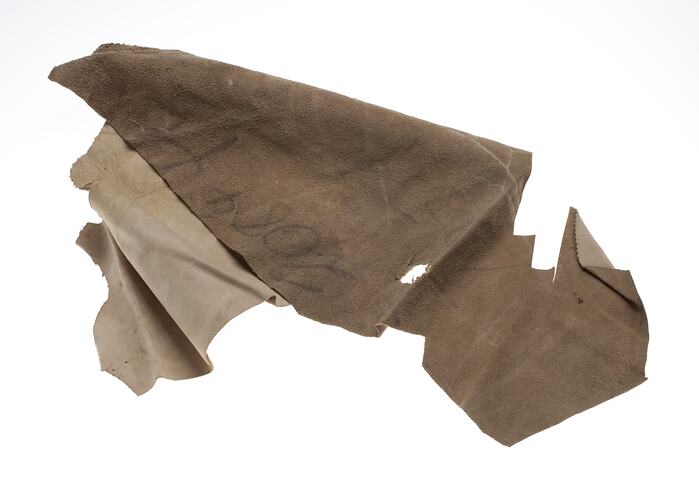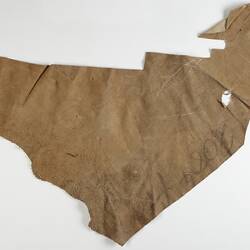Summary
This supple, camel/cream coloured leather remnant appears sporadically cut and indicates the types of leathers and colours that StanioFancoff used within his shoemaking business between the 1930s and 1970s. Along with many other samples, this leather piece was an integral part of the shoemaker's kit that provided aesthetic diversity to his shoemaking craft.
Stanio Ivanoff Fancoff was born in 1908 in Bojentsi, a small village in Bulgaria. At age 11, Stanio left home to learn the shoemaking trade. In 1929, he immigrated to Melbourne, settled in Fitzroy and began to work for the V.G. Zemancheff & Sons basket shoe factory in South Melbourne. In1936, he married Dorotea Georgi Touzou who had recently arrived in Australia. Around this time, Stanio set up his own shoemaking business from home, with Georgi, her cousin and sister weaving the shoes which he then assembled. Select shoe samples were then taken to Sydney and Tasmania for sale. In 1942, Georgi and Stanio moved to Broken Hill for Georgi's health; there daughter Nancy was born and Stanio set up a shoe shop/factory. In 1945, Georgi died and by 1950 Stanio and Nancy had moved to Adelaide where he again opened a shoemaking business and shop. He passed away in 1978, having been in the shoemaking business for 59 years. This collection documents his migration and working life experiences.
Physical Description
Large, supple, camel/cream coloured leather. Sporadically cut, this piece has no definitive outer shape but off centre is one eye shaped hole of approximately 4 x 2cm with a line induced via possibly scraping or burning that extends out on either side. Furthermore, the leather has several random folds with numerous lighter coloured and several stain splotches. On the reverse side, the skin is a light brown hue and the numbers "208441" appear on the top and underneath to the left the numbers "1757"(?) appear.
Significance
This collection is significant in documenting a small migrant business as well as the fashion of a particular period. It is well provenanced and charts the application of trade skills in a new country. It also illustrates the stages of hand shoe manufacture from the 1930s, demonstrating the enduring nature of the tools and patterns that were used.
More Information
-
Collecting Areas
-
Acquisition Information
Donation from Nancy Vasileff, 21 Mar 2007
-
Maker
-
Inscriptions
Numbers: Backside, Skin Area, Top edge line; 208441 Numbers: Backside, Skin Area, Left Top area: 1757 (last number is possibly 7, difficult to read)
-
Classification
-
Category
-
Discipline
-
Type of item
-
Overall Dimensions
835 mm (Length), 500 mm (Width)
-
References
R.A. Salaman, 'Dictionary of Leather-working Tools c.1700-1950 and Tools of Allied Trades,' London: George Allen and Unwin (Publishers) Ltd, 1986 [Section 2: Boot and Shoe Maker pp18-185]. John Peacock. 'Shoes, The Complete Sourcebook,' London:Thames & Hudson Ltd, 2005. NAA holds file (online) on Vasil George Zemancheff, Fancoff's employer
-
Keywords
Boot & Shoemaking, Bulgarian Communities, Bulgarian Immigration, Immigration, Small Businesses, Tools



